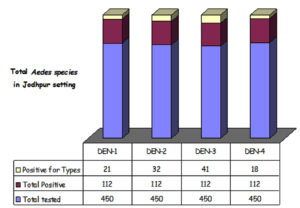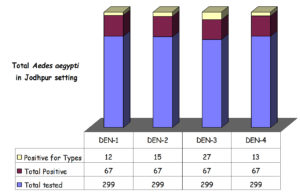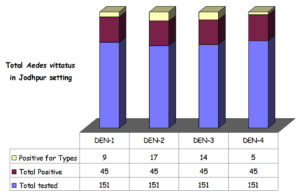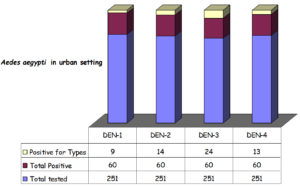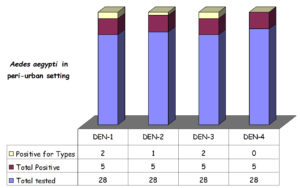ISSN: 0973-7510
E-ISSN: 2581-690X
Dengue Fever and Dengue Hemorrhagic Fever (DHF) stands as the principal cause of prolonged illness and death among individuals of all age groups. The screening of mosquitoes from risk areas and the identification of virus types present can offer crucial epidemiological insights regarding the potential risk of DHF. Therefore, to prove this an investigation was carried out on various dengue virus types present within field-collected Aedes mosquitoes in the urban, rural and peri-urban areas of Jodhpur, Rajasthan, India. Adult Aedes mosquitoes were captured from human residences and outskirts. Individual mosquitoes were subjected to Indirect Fluorescence Antibody Test (IFAT). The virus isolation studies from the Aedes aegypti of peri-urban foci of Jodhpur district have shown maximum presence of DEN-1 and DEN-3 types and none of the mosquitoes positive for DEN-4. On the other hand, from the same settings Aedes vittatus showed DEN-1, 2 and 3 in maximum proportion whereas, DEN-4 virus type, like Aedes aegypti, showed least presence in Aedes vittatus mosquitoes also. Samples combined for all the settings showed that of total 450 mosquitoes screened for dengue antigens, the maximum percentage (36.6%) of DEN-3 type was observed followed by DEN-2 (28.5%), DEN-1 (18.7%) and least in the case of DEN-4 (16.0%). In the arid regions of Jodhpur, where people tend to store domestic water excessively and for extended periods, current findings regarding the presence of all four types of dengue viruses could significantly impact the understanding the risk factors associated with the occurrence of DHF in the area.
Dengue Hemorrhagic Fever, Aedes aegypti, Aedes vittatus, IFA Test
Dengue hemorrhagic fever (DHF) constitutes the predominant etiology of persistent morbidity and mortality in human cases of dengue within endemic regions of Rajasthan.1,2 In order to assess the probability of Dengue Hemorrhagic Fever (DHF) occurrence and to create specialized preventive strategies, it is imperative to pinpoint the specific areas where multiple dengue virus strains are actively circulating in an endemic environment. Analysing the mosquitoes within a particular location and characterizing the viral strains they harbor could serve as an effective method. Also, different loci’s contribute to the occurrence of Dengue in a particular area.
Recognizing that the presence of multiple dengue virus strains within the existing vector population could represent a substantial risk factor for the potential occurrence of Dengue Hemorrhagic Fever (DHF),3 we initiated a comprehensive investigation into viral typing of mosquito samples of Aedes aegypti and Aedes vittatus. The systematic examination of mosquitoes obtained from regions with a high incidence of the disease, along with the subsequent identification of the virus, can offer substantial epidemiological insights into the potential risk of Dengue Hemorrhagic Fever (DHF).4-6 Due to the prevalent issue of water scarcity and inconsistent water provision within the majority of arid districts in this state, individuals tend to store domestic water. This practice establishes a year-round habitat for the domestic breeding of the dengue vector, Ae. aegypti, consequently facilitating the persistence of the dengue virus.7-9 We conducted a research investigation to characterize various dengue virus serotypes present in Aedes aegypti and Aedes vittatus mosquitoes collected from different settings of Jodhpur district in Rajasthan, India, where dengue is endemic.
Collection of mosquitoes from study areas
Adult Aedes mosquitoes were captured from human dwellings in urban and rural regions, as well as from tree holes in peri-urban environments. These field-acquired adult mosquitoes were then transported to the laboratory of Desert Medicine Research Centre, Jodhpur (present National Institute For Implementation Research On Non-Communicable Diseases, Jodhpur), where they were housed in barraud cages under controlled conditions of approximately 25 °C ambient temperature and a relative humidity level of 60-70%. Subsequently, the mosquitoes were provided with a 4% glucose solution for sustenance and were observed in the laboratory for a period of 3-4 days following their collection from the field.
Dengue virus typing
Wild-caught adult female mosquitoes were subjected to an Indirect Fluorescence Antibody Test (IFAT) following blood digestion. The presence of the virus was assessed individually in each mosquito. The head of each tested mosquito was carefully dissected and divided into four segments, with each segment being processed into a spot squash by applying pressure on a slide through coverslip. In the testing process, specific Dengue (DEN) monoclonal antibodies (MABs) for types 1, 2, 3, and 4, commercially obtained from Fitzgerald in Germany, were applied to each segment of the head squash. The segment of the head squash that exhibited a positive reaction in the Indirect Fluorescence Antibody (IFA) test against a particular type of monoclonal antibody (DEN-1, 2, 3, or 4) was recorded as containing that specific dengue type. To visualize the presence of the virus as fluorescence, Fluorescein Isothiocyanate (FITC) obtained from M/s Sigma, USA was used and detection of the virus was observed using a Fluorescence Microscope model BH2 RFL1 PM 10 ADS, (OLYMPUS, Japan).
The IFA test conducted for the 450 mosquitoes collected from the urban, peri-urban and rural foci’s showed positivity in 112 of them (Figure 1-5). This contributed to 24.88% of the total examined. These were tested using the monoclonal antibodies against all the four strains. All the three species were seen to be present in the peri-urban foci while in the rural and urban foci Aedes aegypti and Aedes vittatus were seen. In the urban foci, of the total 251 Aedes aegypti mosquitoes assayed, 60 (23.90%) were seen to be positive for carrying dengue virus. Of them, maximum positivity was found for DEN-3, followed by DEN-2, DEN-4 and DEN-1. The mosquitoes found positive for DEN-3 accounted 40% (60) of the total positivity while others were 21.66% for DEN-2, 23.33% for DEN-4 and 15.00% for DEN-1. Similarly, in the urban foci, two Aedes vittatus were also found, but both were seen to be negative for virus transmission.
Figure 4. Presence of DEN-1, 2, 3 & 4 virus types in mosquito samples of Aedes aegypti in urban setting of Jodhpur
Figure 5. Presence of DEN-1, 2, 3 & 4 virus types in mosquito samples of Aedes aegypti in peri-urban settings of Jodhpur
From rural areas, a total of 20 Aedes aegypti mosquitoes were screened of which, 2 (10.0%) were found infected. Both the infected mosquitoes showed DEN-1 and DEN-3 each (50%) (Table). From the same settings, 72 Aedes vittatus mosquitoes were also examined for the presence of dengue antigen of which 3 mosquitoes showed DEN-1 type (60%) and 2 showed DEN-2 type (40%). None of the mosquitoes screened showed DEN-3 and DEN-4 antigens from this setting.
Table:
Prevalence of different dengue types in mosquito fauna of urban and peri-urban foci of Jodhpur
| Settings of Jodhpur | Species | Total tested | Total +ve | % +ve | +ve for DEN-1 | % +ve for DEN-1 | +ve for DEN-2 | % +ve for DEN-2 | +ve for DEN-3 | % +ve for DEN-3 | +ve for DEN-4 | % +ve for DEN- 4 |
|---|---|---|---|---|---|---|---|---|---|---|---|---|
| Urban | Ae. aegypti | 251 | 60 | 23.90 | 9 | 15.00 | 14 | 23.33 | 24 | 40.00 | 13 | 21.66 |
| Ae. vittatus | 2 | 0 | – | 0 | – | 0 | – | 0 | – | 0 | – | |
| Peri-urban | Ae. aegypti | 28 | 5 | 17.85 | 2 | 40.00 | 1 | 20.00 | 2 | 40.00 | 0 | – |
| Ae. vittatus | 77 | 40 | 51.94 | 6 | 15.00 | 15 | 37.50 | 14 | 35.00 | 5 | 12.50 | |
| Rural | Ae. aegypti | 20 | 2 | 10.00 | 1 | 50.00 | 0 | – | 1 | 50.00 | 0 | – |
| Ae. vittatus | 72 | 5 | 6.94 | 3 | 60.00 | 2 | 40.00 | 0 | – | 0 | – | |
| Total | Ae. aegypti | 299 | 67 | 22.40 | 12 | 17.91 | 15 | 22.38 | 27 | 40.29 | 13 | 19.40 |
| Ae. vittatus | 151 | 45 | 29.80 | 9 | 20.00 | 17 | 37.77 | 14 | 31.11 | 5 | 11.11 | |
| Grand total | 450 | 112 | 24.88 | 21 | 18.75 | 32 | 28.57 | 41 | 36.60 | 18 | 16.07 |
* +ve= Positive
From peri-urban foci, a total of 28 Aedes aegypti mosquitoes were collected and subjected to IFAT. Out of these only 5 (17.8%) were positive for dengue virus antigen. Of this stock, 2 (40.0%) mosquitoes were positive for DEN-1, 1 (20.0%) were found positive for DEN-2, 2 (40.0%) were found positive for DEN-3. The maximum percentage of mosquito infection (40.0%) was found for DEN-1 and DEN-3 types and minimum (20.0%) was observed for DEN-2 type. None of the Aedes aegypti species showed dengue virus antigen for DEN-4 when examined through IFA Test (Table).
From peri-urban foci, 77 Aedes vittatus were subjected to IFA Test of which 40 (51.9%) were positive for dengue antigen. Of this stock, 6 (15.0%) mosquitoes were positive for DEN-1, 15 (37. 5%) were found positive for DEN-2, 14 (35.0%) were found positive for DEN-3 and 5 (12.5%) were found positive for DEN-4. The maximum percentage of mosquito infection (37.5%) was found for DEN-2 followed by 35.0% for DEN-3 type, and minimum (12.5%) was observed for DEN-4 type (Table).
In the current investigation, mosquito infections were identified based on the presence of positive fluorescence in the Indirect Fluorescence Antibody (IFA) test. The arid regions of Jodhpur, Rajasthan, India is characterized by a prevalent practice of prolonged and excessive storage of domestic water.10 The current findings regarding the detection of all four types of the dengue virus (DEN) in field-collected Ae. aegypti mosquitoes thus holds significant implications for the potential emergence of Dengue Hemorrhagic Fever (DHF) in the area.
Typing of virus types among field collected mosquito samples is a new initiation undertaken by us. Surveillance of mosquitoes carrying natural infection of dengue virus and its utility as the predictor of infection is relatively newer area of research on dengue viruses.
ACKNOWLEDGMENTS
None.
CONFLICT OF INTEREST
The authors declare that there is no conflict of interest.
AUTHORS’ CONTRIBUTION
All authors listed have made a substantial, direct and intellectual contribution to the work, and approved it for publication.
FUNDING
None.
DATA AVAILABILITY
All datasets generated or analyzed during this study are included in the manuscript.
ETHICS STATEMENT
Not applicable.
- Sharma P, Sharma M, Bhomia N, et al. Outbreak investigation of Dengue like fever in rural area of Rajasthan. Ind J Med Microbio. 2023;45:100398.
Crossref - Rathore M, Kashyap A, Kapoor P. Journey of dengue in Rajasthan in the last 15 years (2001-2015) with special reference to 2015. Ind J Hlth Sc Biomed Res (KLEU). 2017;10(1):3-8.
Crossref - Angel B, Angel A, Joshi V. Multiple dengue virus types harbored by individual mosquitoes. Acta Trop. 2015;150:107-110.
Crossref - Guha-Sapir D, Schimmer B. Dengue fever: new paradigms for a changing epidemiology. Emerg Themes Epidemiol. 2005;2(1):1.
Crossref - Wang WH, Urbina AN, Chang MR, et al. Dengue hemorrhagic fever – A systemic literature review of current perspectives on pathogenesis, prevention and control. J Microbiol Immuno Infec. 2020;53(6):963-978.
Crossref - Qinlong J, Ming W. Dengue epidemiology. Global Health Journal. 2019;3(2):37-45.
Crossref - Joshi V, Angel A, Angel B, Kucheria K. Egg laying sites of Aedes aegypti and their elimination as the crucial etiological intervention to prevent dengue transmission in Western Rajasthan, India. Int J Sci Res. 2013;2(12):468-469.
Crossref - Angel A, Angel B, Joshi V et al. Significance of Sequential Emergence of Serological Responses by Dengue Patients as Community Level Sero-Epidemiological Indicators of Disease Progression: A Study in Barmer, Rajasthan, India. Ind J APp Res. 2014; 4(5):24-26.
Crossref - Angel A, Angel B, Joshi V. Rare occurrence of natural Transovarial Transmission of dengue virus and elimination of infected foci as a possible intervention method. Acta Trop. 2016;155:1-5.
Crossref - Joshi V, Sharma RC, Sharma Y, et al. Importance of socio-economic status and tree holes in distribution of Aedes mosquitoes (Diptera:Culicidae) in Jodhpur, Rajasthan, India. J Med Entomol 2006;43(2):330-336.
Crossref
© The Author(s) 2025. Open Access. This article is distributed under the terms of the Creative Commons Attribution 4.0 International License which permits unrestricted use, sharing, distribution, and reproduction in any medium, provided you give appropriate credit to the original author(s) and the source, provide a link to the Creative Commons license, and indicate if changes were made.



